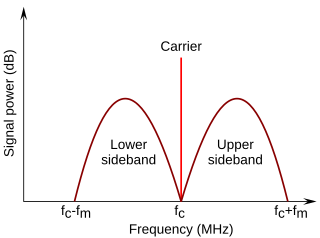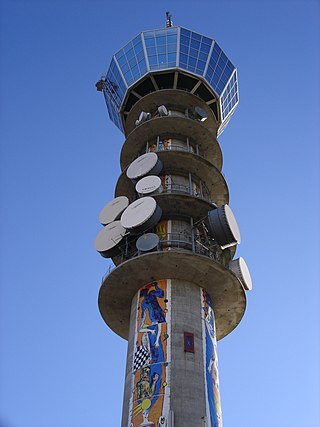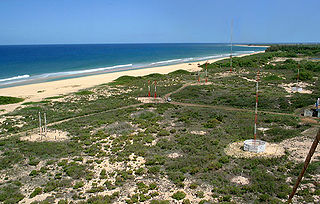
In radio communications, a sideband is a band of frequencies higher than or lower than the carrier frequency, that are the result of the modulation process. The sidebands carry the information transmitted by the radio signal. The sidebands comprise all the spectral components of the modulated signal except the carrier. The signal components above the carrier frequency constitute the upper sideband (USB), and those below the carrier frequency constitute the lower sideband (LSB). All forms of modulation produce sidebands.

Shortwave radio is radio transmission using radio frequencies in the shortwave bands (SW). There is no official definition of the band, but the range always includes all of the high frequency band (HF), which extends from 3 to 30 MHz ; above the medium frequency band (MF), to the bottom of the VHF band.

A radio clock or radio-controlled clock (RCC), and often colloquially referred to as an "atomic clock", is a type of quartz clock or watch that is automatically synchronized to a time code transmitted by a radio transmitter connected to a time standard such as an atomic clock. Such a clock may be synchronized to the time sent by a single transmitter, such as many national or regional time transmitters, or may use the multiple transmitters used by satellite navigation systems such as Global Positioning System. Such systems may be used to automatically set clocks or for any purpose where accurate time is needed. Radio clocks may include any feature available for a clock, such as alarm function, display of ambient temperature and humidity, broadcast radio reception, etc.

In radio, longwave, long wave or long-wave, and commonly abbreviated LW, refers to parts of the radio spectrum with wavelengths longer than what was originally called the medium-wave broadcasting band. The term is historic, dating from the early 20th century, when the radio spectrum was considered to consist of longwave (LW), medium-wave (MW), and short-wave (SW) radio bands. Most modern radio systems and devices use wavelengths which would then have been considered 'ultra-short'.

Radio broadcasting is the broadcasting of audio (sound), sometimes with related metadata, by radio waves to radio receivers belonging to a public audience. In terrestrial radio broadcasting the radio waves are broadcast by a land-based radio station, while in satellite radio the radio waves are broadcast by a satellite in Earth orbit. To receive the content the listener must have a broadcast radio receiver (radio). Stations are often affiliated with a radio network that provides content in a common radio format, either in broadcast syndication or simulcast, or both. Radio stations broadcast with several different types of modulation: AM radio stations transmit in AM, FM radio stations transmit in FM, which are older analog audio standards, while newer digital radio stations transmit in several digital audio standards: DAB, HD radio, DRM. Television broadcasting is a separate service that also uses radio frequencies to broadcast television (video) signals.

Digital Radio Mondiale is a set of digital audio broadcasting technologies designed to work over the bands currently used for analogue radio broadcasting including AM broadcasting—particularly shortwave—and FM broadcasting. DRM is more spectrally efficient than AM and FM, allowing more stations, at higher quality, into a given amount of bandwidth, using xHE-AAC audio coding format. Various other MPEG-4 codecs and Opus are also compatible, but the standard now specifies xHE-AAC.
CHU is the call sign of a shortwave time signal radio station operated by the Institute for National Measurement Standards of the National Research Council. CHU's signal is used for continuous dissemination of official Canadian government time signals, derived from atomic clocks.
Radio VNG was Australia's national time signal service. It was inaugurated by the Australian Post Office at Lyndhurst, Victoria on 21 September 1964, although a predecessor service using the callsign VLX had begun in March 1946 alongside shortwave radio station VLR. From 1964 until 1987, Radio VNG transmitted on 4.5, 7.5 and 12 MHz from the Lyndhurst transmitters. After 1987 it relocated to Shanes Park, NSW, and transmitted on 2.5, 5, 8.638, 12.984, and 16 MHz.

WWV is a shortwave radio station, located near Fort Collins, Colorado. It has broadcast a continuous time signal since 1945, and implements United States government frequency standards, with transmitters operating on 2.5, 5, 10, 15, and 20 MHz. WWV is operated by the U.S. National Institute of Standards and Technology (NIST), under the oversight of its Time and Frequency Division, which is part of NIST's Physical Measurement Laboratory based in Gaithersburg, Maryland.

WWVH is the callsign of the U.S. National Institute of Standards and Technology's shortwave radio time signal station located at the Barking Sands Missile Range, in Kekaha, on the island of Kauai in the state of Hawaii.
WWVB is a time signal radio station near Fort Collins, Colorado and is operated by the National Institute of Standards and Technology (NIST). Most radio-controlled clocks in North America use WWVB's transmissions to set the correct time. The 70 kW ERP signal transmitted from WWVB is a continuous 60 kHz carrier wave, the frequency of which is derived from a set of atomic clocks located at the transmitter site, yielding a frequency uncertainty of less than 1 part in 1012. A one-bit-per-second time code, which is based on the IRIG "H" time code format and derived from the same set of atomic clocks, is then modulated onto the carrier wave using pulse-width modulation and amplitude-shift keying. A single complete frame of time code begins at the start of each minute, lasts one minute, and conveys the year, day of year, hour, minute, and other information as of the beginning of the minute.
RWM is the callsign of a high frequency (shortwave) standard frequency and time signal radio station in Moscow, Russia. It is controlled by All-Russian Scientific Research Institute for Physical-Engineering and Radiotechnical Metrology, and operated by Russian Television and Radio Broadcasting Network. Transmitting frequencies are 4.996 MHz with 5 kW and on 9.996 and 14.996 MHz with 8 kW.
JJY is the call sign of a low frequency time signal radio station located in Japan.

DUT1 is a time correction equal to the difference between Universal Time (UT1), which is defined by Earth's rotation, and Coordinated Universal Time (UTC), which is defined by a network of precision atomic clocks.
RBU is a time code radio station located in Moscow. It transmits a continuous 10 kW time code on 66⅔ kHz. This is commonly written as 66.66 or 66.666 kHz, but is actually 200/3 kHz. Until 2008, the transmitter site was near Kupavna 55°44′04″N38°9′0″E and used as antenna three T-antennas spun between three 150 metres tall grounded masts. In 2008, it has been transferred to the Taldom transmitter at 56°44′00″N37°39′48″E.
BPC is the callsign of a time signal broadcasting from the BPC Shangqiu Low-Frequency Time-Code Radio Station, cooperatively constructed by the National Time Service Center of the Chinese Academy of Sciences and Xi’an Gaohua Technology Co., Ltd., beginning April 25, 2002.
BPL is the call sign of the official long-wave time signal service of the People's Republic of China, operated by the Chinese Academy of Sciences, broadcasting on 100 kHz from CAS's National Time Service Center in Pucheng County, Shaanxi at 34°56′54″N109°32′34″E, roughly 70 km northeast of Lintong, along with NTSC's short-wave time signal BPM on 2.5, 5.0, 10.0, and 15.0 MHz.
JN53dv is the Maidenhead grid square of an experimental shortwave time signal station in Italy. It is located in the town of Corsanico-Bargecchia near Massarosa and operated by Italcable
The National Time Service Center has the task of generating, maintaining and broadcasting standard time in China. It is located in Xi'an, Shaanxi, China. Its predecessor was the Shaanxi Astronomy Observatory of the Chinese Academy of Sciences, which was established in 1966. In March 2001, the Observatory was renamed to National Time Service Center of the Chinese Academy of Sciences.











